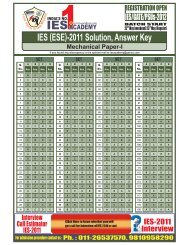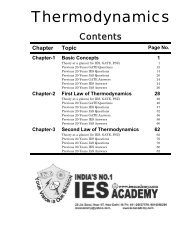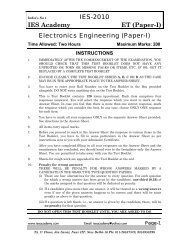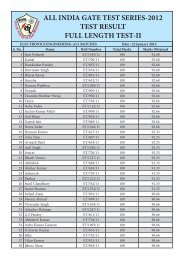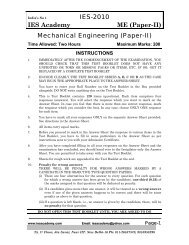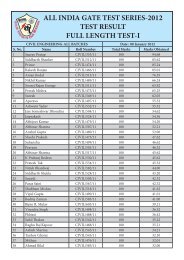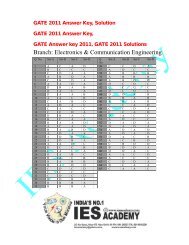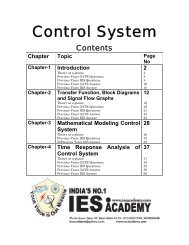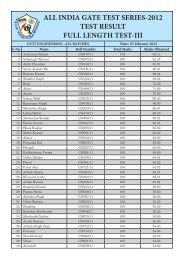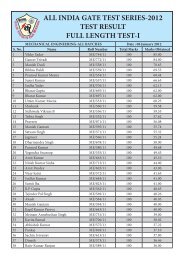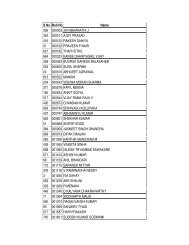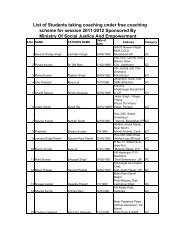Electrical Machine - IES Academy
Electrical Machine - IES Academy
Electrical Machine - IES Academy
Create successful ePaper yourself
Turn your PDF publications into a flip-book with our unique Google optimized e-Paper software.
India’s No. 1<br />
<strong>IES</strong> <strong>Academy</strong><br />
Transformer<br />
Chapter-1<br />
Core<br />
The magnetic core is a stack of thin silicon-steel laminations about 0.35 mm thick for 50 Hz<br />
transformer. It provides magnetic coupling between two (or more) isolated electrical circuits.<br />
To minimize core losses, core should be made of a highly permeable material. Hence, core is<br />
made from cold-rolled grain-oriented sheet-steel (C.R.G.O.) magnetized in the rolling direction.<br />
The core is laminated to reduce the eddy current losses.<br />
In the core-type, the windings surround a considerable part of the steel core. In the shell-type,<br />
the steel core surrounds a major part of the windings. For single-phase transformers, core-type<br />
has two legged core while shell-type has three legged core.<br />
Both the high voltage winding and the low voltage winding are divided on both the limbs.<br />
When half of winding is placed on either limb, the leakage flux would correspond to only half<br />
magnetic vector. Thus, the windings are divided to reduce leakage flux (flux that links<br />
one winding and not the other). The low voltage (L.V.) winding is placed near to the steel core<br />
in order to minimize the amount of insulation required.<br />
In the shell type transformer, the L.V. and H.V. windings are wound over the central limb and<br />
are interleaved or sandwiched as shown in Figure. The bottom and top L.V. coils are of half<br />
the size of other L.V. coils. Shell-type transformers are preferred for low-voltage low-power<br />
levels, whereas core-type construction is used for high-voltage, high-power transformers.<br />
In core-type transformer, the flux has a single path around the legs or yokes. In the shell-type<br />
transformer, the flux in the central limb divides equally and returns through the outer two<br />
legs.<br />
There are two types of windings employed for transformers. The concentric coils are used<br />
for core-type transformers and interleaved (or sandwiched) coils for shell-type<br />
transformers.<br />
During the assembly of the steel core, the butt joints are staggered to reduce the reluctance<br />
and it provides mechanical strength to the core. Low power transformers are air-cooled where<br />
as large power- transformers are immersed in oil for better cooling. In oil-cooled transformers,<br />
oil acts as coolant and as insulating medium.<br />
Pulse transformers have cores made of soft ferrites. In communication circuits (high<br />
frequency circuits), cores are made of powdered ferromagnetic alloys. Air-core (core of nonmagnetic<br />
material) transformers are used in radio devices.<br />
The cores are stepped in transformers to obtain optimum use of the copper material used for<br />
winding and ferroelectric material for core.<br />
Principle of Transformer Action<br />
A transformer works on the principle of electromagnetic induction according to which emf is<br />
induced in a coil if it links a changing flux. When the primary winding is supplied with an ac<br />
source, an alternating mutual flux linking both the windings is set up, which induces<br />
voltage in the primary and secondary windings.<br />
www.iesacademy.com E-mail: iesacademy@yahoo.com Page-2<br />
25, 1 st Floor, Jia Sarai, Near IIT. New Delhi-16 Ph: 011-26537570, 9810958290



